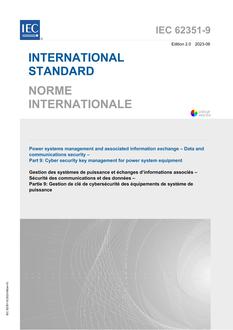This part of IEC 62351 specifies cryptographic key management, primarily focused on the management of long-term keys, which are most often asymmetric key pairs, such as public-key certificates and corresponding private keys. As certificates build the base this document builds a foundation for many IEC 62351 services (see also Annex A). Symmetric key management is also considered but only with respect to session keys for group-based communication as applied in IEC 62351-6. The objective of this document is to define requirements and technologies to achieve interoperability of key management by specifying or limiting key management options to be used.
This document assumes that an organization (or group of organizations) has defined a security policy to select the type of keys and cryptographic algorithms that will be utilized, which may have to align with other standards or regulatory requirements. This document therefore specifies only the management techniques for these selected key and cryptography infrastructures. This document assumes that the reader has a basic understanding of cryptography and key management principles.
The requirements for the management of pairwise symmetric (session) keys in the context of communication protocols is specified in the parts of IEC 62351 utilizing or specifying pairwise communication such as:
• IEC 62351-3 for TLS by profiling the TLS options
• IEC 62351-4 for the application layer end-to-end security
• IEC TS 62351-5 for the application layer security mechanism for IEC 60870-5-101/104 and IEEE 1815 (DNP3)
The requirements for the management of symmetric group keys in the context of power system communication protocols is specified in IEC 62351-6 for utilizing group security to protect GOOSE and SV communication. IEC 62351-9 utilizes GDOI as already IETF specified group-based key management protocol to manage the group security parameter and enhances this protocol to carry the security parameter for GOOSE, SV, and PTP.
This document also defines security events for specific conditions which could identify issues which might require error handling. However, the actions of the organisation in response to these error conditions are beyond the scope of this document and are expected to be defined by the organizations security policy.
In the future, as public-key cryptography becomes endangered by the evolution of quantum computers, this document will also consider post-quantum cryptography to a certain extent. Note that at this time being no specific measures are provided.
Product Details
- Edition:
- 2.0
- Published:
- 06/01/2023
- ISBN(s):
- 9782832269503
- Number of Pages:
- 300
- File Size:
- 1 file , 7.6 MB
- Note:
- This product is unavailable in Ukraine, Russia, Belarus
